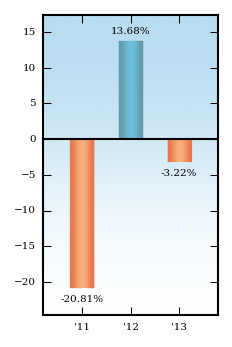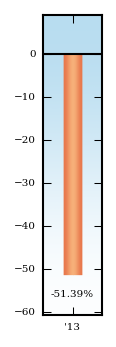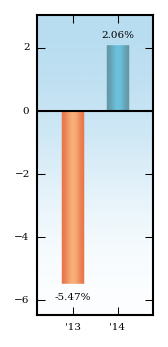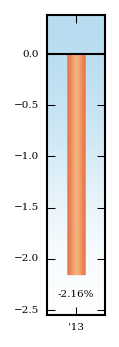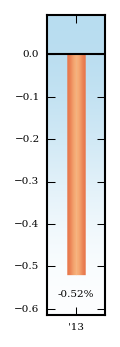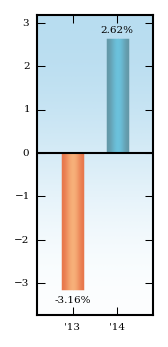| iShares MSCI Global Gold Miners ETF | |||||||||||||||||||||||||||
| iSHARES® MSCI GLOBAL GOLD MINERS ETF Ticker: RING Stock Exchange: NYSE Arca | |||||||||||||||||||||||||||
| Investment Objective | |||||||||||||||||||||||||||
| The iShares MSCI Global Gold Miners ETF (the “Fund”) seeks to track the investment results of an index composed of global equities of companies primarily engaged in the business of gold mining. | |||||||||||||||||||||||||||
| Fees and Expenses | |||||||||||||||||||||||||||
| The following table describes the fees and expenses that you will incur if you own shares of the Fund. The investment advisory agreement between iShares, Inc. (the “Company”) and BlackRock Fund Advisors (“BFA”) (formerly, Barclays Global Fund Advisors (“BGFA”)) (the “Investment Advisory Agreement”) provides that BFA will pay all operating expenses of the Fund, except interest expenses, taxes, brokerage expenses, future distribution fees or expenses, and extraordinary expenses. You may also incur usual and customary brokerage commissions when buying or selling shares of the Fund, which are not reflected in the Example that follows: | |||||||||||||||||||||||||||
| Annual Fund Operating Expenses (ongoing expenses that you pay each year as a percentage of the value of your investments) | |||||||||||||||||||||||||||
| |||||||||||||||||||||||||||
| Example. | |||||||||||||||||||||||||||
| This Example is intended to help you compare the cost of owning shares of the Fund with the cost of investing in other funds. The Example assumes that you invest $10,000 in the Fund for the time periods indicated and then sell all of your shares at the end of those periods. The Example also assumes that your investment has a 5% return each year and that the Fund’s operating expenses remain the same. Although your actual costs may be higher or lower, based on these assumptions, your costs would be: | |||||||||||||||||||||||||||
| |||||||||||||||||||||||||||
| Portfolio Turnover. | |||||||||||||||||||||||||||
| The Fund may pay transaction costs, such as commissions, when it buys and sells securities (or “turns over” its portfolio). A higher portfolio turnover rate may indicate higher transaction costs and may result in higher taxes when Fund shares are held in a taxable account. These costs, which are not reflected in Annual Fund Operating Expenses or in the Example, affect the Fund's performance. During the most recent fiscal year, the Fund's portfolio turnover rate was 22% of the average value of its portfolio. | |||||||||||||||||||||||||||
| Principal Investment Strategies | |||||||||||||||||||||||||||
| The Fund seeks to track the investment results of the MSCI ACWI Select Gold Miners Investable Market Index (IMI) (the “Underlying Index”), which has been developed by MSCI Inc. (“MSCI”) to measure the combined performance of equity securities of companies primarily engaged in the business of gold mining in both developed and emerging markets. MSCI begins with the MSCI ACWI Investable Market Index (IMI), and then selects securities of companies that are primarily focused on the extraction and production of gold, and companies that generally do not engage in hedging activity with respect to gold prices. The price of the equity securities of these companies and the price of gold may not always be closely correlated. The Underlying Index may include large-, mid- or small-capitalization companies. As of June 30, 2014, the Underlying Index consisted of companies in the following nine countries or regions: Australia, Canada, China, Hong Kong, Peru, South Africa, Turkey, the United Kingdom and the United States. The Fund, under normal market conditions, will invest at least 40% of its assets in issuers organized or located outside the United States or doing business outside the United States. BFA uses a “passive” or indexing approach to try to achieve the Fund’s investment objective. Unlike many investment companies, the Fund does not try to “beat” the index it tracks and does not seek temporary defensive positions when markets decline or appear overvalued. Indexing may eliminate the chance that the Fund will substantially outperform the Underlying Index but also may reduce some of the risks of active management, such as poor security selection. Indexing seeks to achieve lower costs and better after-tax performance by keeping portfolio turnover low in comparison to actively managed investment companies. BFA uses a representative sampling indexing strategy to manage the Fund. “Representative sampling” is an indexing strategy that involves investing in a representative sample of securities that collectively has an investment profile similar to that of the Underlying Index. The securities selected are expected to have, in the aggregate, investment characteristics (based on factors such as market capitalization and industry weightings), fundamental characteristics (such as return variability and yield) and liquidity measures similar to those of the Underlying Index. The Fund may or may not hold all of the securities in the Underlying Index. The Fund generally will invest at least 90% of its assets in the component securities of the Underlying Index and in investments that have economic characteristics that are substantially identical to the component securities of the Underlying Index (i.e., depositary receipts representing securities of the Underlying Index) and may invest up to 10% of its assets in certain futures, options and swap contracts, cash and cash equivalents, including shares of money market funds advised by BFA or its affiliates, as well as in securities not included in the Underlying Index, but which BFA believes will help the Fund track the Underlying Index. The Fund seeks to track the investment results of the Underlying Index before the fees and expenses of the Fund. The Fund may lend securities representing up to one-third of the value of the Fund's total assets (including the value of the collateral received). The Underlying Index is calculated by an organization (the “Index Provider”) that is independent of the Fund and BFA. The Index Provider determines the composition and relative weightings of the securities in the Underlying Index and publishes information regarding the market value of the Underlying Index. The Fund’s Index Provider is MSCI. Industry Concentration Policy. The Fund will concentrate its investments (i.e., hold 25% or more of its total assets) in a particular industry or group of industries to approximately the same extent that the Underlying Index is concentrated. For purposes of this limitation, securities of the U.S. government (including its agencies and instrumentalities) and repurchase agreements collateralized by U.S. government securities are not considered to be issued by members of any industry. | |||||||||||||||||||||||||||
| Summary of Principal Risks | |||||||||||||||||||||||||||
| As with any investment, you could lose all or part of your investment in the Fund, and the Fund's performance could trail that of other investments. The Fund is subject to the principal risks noted below, any of which may adversely affect the Fund's net asset value per share (“NAV”), trading price, yield, total return and ability to meet its investment objective. Asset Class Risk. Securities in the Underlying Index or in the Fund's portfolio may underperform in comparison to the general securities markets, a particular securities market or other asset classes. Commodity Risk. The Fund invests in companies that are susceptible to fluctuations in certain commodity markets. Any negative changes in commodity markets could have an adverse impact on those companies. Concentration Risk. The Fund may be susceptible to an increased risk of loss, including losses due to adverse occurrences affecting the Fund more than the market as a whole, to the extent that the Fund's investments are concentrated in the securities of a particular issuer or issuers, country, group of countries, region, market, industry, group of industries, sector or asset class. Currency Risk. Because the Fund's NAV is determined in U.S. dollars, the Fund's NAV could decline if the currency of a non-U.S. market in which the Fund invests depreciates against the U.S. dollar. Custody Risk. Less developed markets are more likely to experience problems with the clearing and settling of trades and the holding of securities by local banks, agents and depositories. Equity Securities Risk. Equity securities are subject to changes in value and their values may be more volatile than those of other asset classes. Geographic Risk. A natural or other disaster could occur in a geographic region in which the Fund invests, which could affect the economy or particular business operations of companies in the specific geographic region, causing an adverse impact on the Fund's investments in the affected region. Gold Mining Sub-Industry Risk. The profitability of companies in the gold mining sub-industry is related to, among other things, the worldwide price of gold and the costs of extraction and production. Worldwide gold prices may fluctuate substantially over short periods of time, so the Fund’s share price may be more volatile than other types of investments. Gold mining companies may be adversely affected by changes in exchange rates, interest rates, economic conditions, tax treatment, government regulation and intervention and world events in the regions in which the companies operate (e.g., expropriation, nationalization, confiscation of assets and property, repatriation of capital, military coups, social unrest, violence and labor unrest). The price of the equity securities of these companies and the price of gold may not always be closely correlated. Index-Related Risk. There is no guarantee that the Fund will achieve a high degree of correlation to the Underlying Index and therefore achieve its investment objective. Market disruptions and regulatory restrictions could have an adverse effect on the Fund’s ability to adjust its exposure to the required levels in order to track the Underlying Index. Errors in the construction of the Underlying Index in accordance with its methodology may occur from time to time and may not be identified and corrected by the Index Provider for a period of time, which may have an adverse impact on the Fund and its shareholders. Issuer Risk. Fund performance depends on the performance of individual securities to which the Fund has exposure. Changes in the financial condition or credit rating of an issuer of those securities may cause the value of the securities to decline. Management Risk. As the Fund may not fully replicate the Underlying Index, it is subject to the risk that BFA's investment strategy may not produce the intended results. Market Risk. The Fund could lose money over short periods due to short-term market movements and over longer periods during market downturns. Market Trading Risk. The Fund faces numerous market trading risks, including the potential lack of an active market for Fund shares, losses from trading in secondary markets, periods of high volatility and disruption in the creation/redemption process of the Fund. ANY OF THESE FACTORS, AMONG OTHERS, MAY LEAD TO THE FUND'S SHARES TRADING AT A PREMIUM OR DISCOUNT TO NAV. Materials Sector Risk. The Fund may invest significantly in companies in the materials sector. Companies in the materials sector may be adversely impacted by the volatility of commodity prices, exchange rates, depletion of resources, over-production, litigation and government regulations, among other factors. Mid-Capitalization Companies Risk. Compared to large-capitalization companies, mid-capitalization companies may be less stable and more susceptible to adverse developments, and their securities may be more volatile and less liquid. Non-Diversification Risk. The Fund may invest a large percentage of its assets in securities issued by or representing a small number of issuers. As a result, the Fund's performance may depend on the performance of a small number of issuers. Non-U.S. Securities Risk. Investments in the securities of non-U.S. issuers are subject to the risks associated with investing in those non-U.S. markets, such as heightened risks of inflation or nationalization. The Fund may lose money due to political, economic and geographic events affecting issuers of non-U.S. securities or non-U.S. markets. The Fund is specifically exposed to North American Economic Risk. Passive Investment Risk. The Fund is not actively managed and BFA does not attempt to take defensive positions under any market conditions, including declining markets. Privatization Risk. Some countries in which the Fund invests have privatized, or have begun the process of privatizing, certain entities and industries. Privatized entities may lose money or be re-nationalized. Reliance on Trading Partners Risk. The Fund invests in countries whose economies are heavily dependent upon trading with key partners. Any reduction in this trading may have an adverse impact on the Fund's investments. Through its portfolio companies' trading partners, the Fund is specifically exposed to Asian Economic Risk, North American Economic Risk and U.S. Economic Risk. Risk of Investing in Canada. Investments in Canadian issuers may subject the Fund to economic risk specific to Canada. Among other things, the Canadian economy is heavily dependent on relationships with certain key trading partners, including the United States, European Union (the “EU”) countries and China. The Canadian economy is sensitive to fluctuations in certain commodity markets. Risk of Investing in Emerging Markets. The Fund's investments in emerging market issuers may be subject to a greater risk of loss than investments in issuers located or operating in more developed markets. Emerging markets may be more likely to experience inflation, political turmoil and rapid changes in economic conditions than more developed markets. Emerging markets often have less uniformity in accounting and reporting requirements, less reliable securities valuation and greater risk associated with custody of securities than developed markets. Securities Lending Risk. The Fund may engage in securities lending. Securities lending involves the risk that the Fund may lose money because the borrower of the loaned securities fails to return the securities in a timely manner or at all. The Fund could also lose money in the event of a decline in the value of the collateral provided for loaned securities or a decline in the value of any investments made with cash collateral. These events could also trigger adverse tax consequences for the Fund. Security Risk. Some countries and regions in which the Fund invests have experienced security concerns. Incidents involving a country's or region's security may cause uncertainty in these markets and may adversely affect their economies and the Fund's investments. Structural Risk. The countries in which the Fund invests may be subject to considerable degrees of economic, political and social instability. Tracking Error Risk. Tracking error is the divergence of the Fund’s performance from that of the Underlying Index. Tracking error may occur because of differences between the securities held in the Fund’s portfolio and those included in the Underlying Index, pricing differences (including differences between a security’s price at the local market close and the intrinsic value of a security at the time of calculation of the NAV), transaction costs, the Fund’s holding of cash, differences in timing of the accrual of dividends, changes to the Underlying Index or the need to meet various new or existing regulatory requirements. This risk may be heightened during times of increased market volatility or other unusual market conditions. Tracking error also may result because the Fund incurs fees and expenses, while the Underlying Index does not. Valuation Risk. The sale price the Fund could receive for a security may differ from the Fund's valuation of the security and may differ from the value used by the Underlying Index, particularly for securities or assets that trade in low volume or volatile markets or that are valued using a fair value methodology. In addition, the value of the securities or assets in the Fund's portfolio may change on days when shareholders will not be able to purchase or sell the Fund's shares. | |||||||||||||||||||||||||||
| Performance Information | |||||||||||||||||||||||||||
| The bar chart and table that follow show how the Fund has performed on a calendar year basis and provide an indication of the risks of investing in the Fund. Both assume that all dividends and distributions have been reinvested in the Fund. Past performance (before and after taxes) does not necessarily indicate how the Fund will perform in the future. Supplemental information about the Fund’s performance is shown under the heading Total Return Information in the Supplemental Information section of the Prospectus. | |||||||||||||||||||||||||||
| Year by Year Returns (Year Ended December 31) | |||||||||||||||||||||||||||
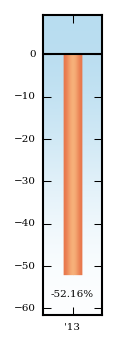
| |||||||||||||||||||||||||||
| The best calendar quarter return during the period shown above was 8.57% in the 3rd quarter of 2013; the worst was -38.25% in the 2nd quarter of 2013. Updated performance information is available at www.iShares.com or by calling 1-800-iShares (1-800-474-2737) (toll free). | |||||||||||||||||||||||||||
| Average Annual Total Returns (for the periods ended December 31, 2013) | |||||||||||||||||||||||||||
| |||||||||||||||||||||||||||


